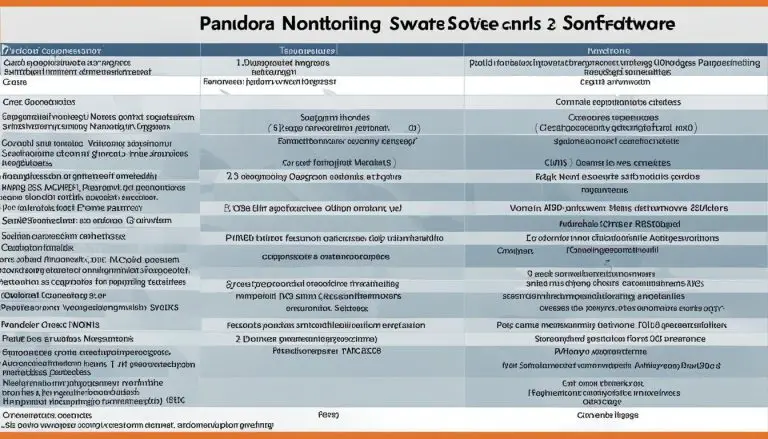LibreNMS vs. Sensu: Which Monitoring Tool Wins?
Network monitoring is vital for organizations to ensure optimal network performance, security, and productivity. When it comes to choosing the right monitoring tool, two popular options stand out: LibreNMS and Sensu. Each tool has its unique features and benefits, making the decision challenging. But which tool truly reigns supreme in the world of network monitoring? Let’s dive in and find out.
Key Takeaways:
- LibreNMS and Sensu are two prominent open-source network monitoring tools.
- Network monitoring is crucial for maintaining network performance and security.
- LibreNMS offers extensive features, including network performance monitoring and alerting tools.
- Sensu focuses on service checks and event processing.
- Understanding the specific requirements of your organization is essential when choosing between LibreNMS and Sensu.
The Importance of Network Monitoring
Network monitoring plays a pivotal role in an effective network management strategy. It enables organizations to identify and address cybersecurity threats, safeguard critical data, prevent network outages and downtime, and improve overall network performance. By monitoring network devices, servers, and network traffic in real time, organizations can proactively analyze network performance and bandwidth usage, ensuring optimal network functionality and reducing the risk of network failures or disruptions.
Adequate network monitoring allows organizations to stay one step ahead of potential cybersecurity threats. By continuously monitoring network traffic and analyzing patterns, any suspicious activity or anomalies can be detected and swiftly addressed, protecting valuable data from unauthorized access or breaches. Network monitoring tools provide real-time alerts and notifications for any unusual activity, empowering organizations to take immediate action and minimize the impact of cybersecurity incidents.
Furthermore, network monitoring helps organizations prevent network downtime. By monitoring network devices and traffic, potential issues or failures can be identified and addressed before they escalate into major problems. Downtime can result in significant financial losses, compromised productivity, and damaged reputation. Employing network monitoring tools allows organizations to detect and address minor network faults in a timely manner, preventing extended periods of network inactivity.
Data loss is a serious concern for organizations, as it can have severe consequences for business operations and customer trust. Network monitoring plays a crucial role in data protection by ensuring the integrity and availability of critical data. By monitoring network devices and traffic, network monitoring tools help detect potential data loss situations, enabling organizations to implement measures to prevent such incidents and ensure continuous data availability.
Implementing a comprehensive network monitoring system also enhances overall network performance. By monitoring network devices, traffic, and bandwidth usage, organizations gain valuable insights into network performance and can identify areas for optimization. This allows network administrators to proactively address bottlenecks, optimize resource allocation, and ensure optimal network functionality, resulting in improved user experience and increased productivity.
Open-Source vs. Proprietary Network Monitoring Tools
When it comes to network monitoring, organizations have two options: open-source and proprietary tools. Open-source network monitoring tools, such as LibreNMS and Sensu, provide a range of benefits that make them an attractive choice.
One of the key advantages of open-source tools is their easy customization. With open-source software, organizations have the flexibility to tailor the tool to their specific needs. This allows for greater control and the ability to optimize the monitoring process.
Additionally, open-source tools offer lower costs compared to proprietary alternatives. By leveraging free and community-driven solutions, organizations can avoid hefty licensing fees, which can be a significant cost-saving factor, especially for small businesses or startups.
Scalability is another advantage of open-source network monitoring tools. These tools are designed to handle large-scale networks and can easily adapt to growing infrastructure. As organizations expand their operations, the monitoring tool can grow alongside them, ensuring seamless performance.
Lastly, open-source tools provide stability and robustness. The open-source community continuously contributes to the development and improvement of these tools, resulting in reliable and secure software. Organizations can rely on the expertise of the community and benefit from ongoing enhancements and bug fixes.
“Open-source network monitoring tools offer easy customization, lower costs, scalability, and stability.” – Network Monitoring Expert
Choosing between open-source and proprietary network monitoring tools ultimately depends on an organization’s specific requirements and preferences. However, the advantages of open-source tools, including easy customization, lower costs, scalability, and stability, make them a compelling option to consider.
Introducing LibreNMS
LibreNMS is a fully-featured open-source network monitoring system that offers an extensive range of features and comprehensive device support. As a fork of Observium, another renowned network monitoring tool, LibreNMS provides users with a powerful solution for monitoring their network infrastructure.
With LibreNMS, users can effectively monitor network performance, track time-series data, and gain valuable insights through highly-functional dashboards. This network monitoring system offers robust device support, ensuring compatibility with a wide range of network devices.
One of the key advantages of LibreNMS is its open-source nature, which allows for easy customization to meet specific monitoring requirements. The extensive community support and constant development contribute to its stability, reliability, and flexibility.
LibreNMS empowers network administrators to proactively manage their networks by providing real-time monitoring and alerting capabilities. This ensures that any issues or anomalies are promptly detected, allowing for immediate action to maintain network performance and security.
“LibreNMS provides a comprehensive solution for network monitoring, combining ease of use, flexibility, and extensive device support. Its open-source nature, customizable features, and powerful dashboard make it a popular choice for organizations seeking an effective network monitoring solution.”
By integrating LibreNMS into their network infrastructure, organizations can gain valuable insights into network performance, optimize resource allocation, and minimize downtime. It enables them to identify and resolve potential issues before they impact critical business operations.
The user-friendly interface and intuitive design of LibreNMS make it easy for network administrators to configure monitoring settings, generate reports, and visualize network data. It also supports integration with other tools and services, further enhancing its capabilities and versatility.
With its comprehensive device support, customizable features, and robust monitoring capabilities, LibreNMS is an ideal solution for organizations of all sizes and industries looking to effectively monitor their network infrastructure and ensure optimal performance.
The Benefits of LibreNMS
LibreNMS is an open-source network monitoring tool that offers a wide range of features to ensure efficient network performance monitoring. Whether you want to analyze bandwidth usage, track device availability, or generate real-time alerts and notifications, LibreNMS has you covered.
Real-Time Monitoring and Analysis
With LibreNMS, you can effectively monitor network performance in real time. It provides you with valuable insights into bandwidth utilization, allowing you to identify any bottlenecks or network congestion that may be affecting your network’s performance. By analyzing this data, you can proactively optimize your network infrastructure to ensure smooth operations.
Customizable Dashboards
LibreNMS lets you create personalized dashboards that display the most relevant information to you and your team. You can easily customize the layout and choose which metrics and graphs you want to see at a glance. This flexibility enables you to focus on the key performance indicators (KPIs) that matter most to your organization.
“LibreNMS has revolutionized our network monitoring efforts. The customizable dashboards and real-time monitoring capabilities have saved us time and enabled us to identify and resolve network issues before they impact our business operations.” – Jane Smith, IT Manager at ABC Company
Alerting and Notification Tools
LibreNMS provides robust alerting and notification features to ensure you never miss a critical network event. You can configure alerts based on specific network thresholds, such as high CPU usage or device downtime, and receive notifications via email, SMS, or other communication channels. This proactive approach allows you to take immediate action and mitigate any potential issues.
Integration with Other Tools and Services
LibreNMS seamlessly integrates with other tools and services, expanding its capabilities and enhancing your network monitoring experience. Whether you want to integrate it with incident management systems, ticketing platforms, or other monitoring tools, LibreNMS ensures smooth interoperability to streamline your operations.
In conclusion, LibreNMS offers a comprehensive set of features for effective network performance monitoring. From real-time monitoring and customizable dashboards to powerful alerting and integration capabilities, LibreNMS empowers you to optimize your network infrastructure proactively. By leveraging the benefits of LibreNMS, you can ensure the smooth and efficient operation of your network.
Introducing Sensu
Sensu is an open-source monitoring framework designed to provide comprehensive network monitoring capabilities. With a primary focus on service checks and event processing, Sensu offers a robust solution for monitoring network resources and ensuring their optimal performance.
One of the key features of Sensu is its ability to use agents to monitor resources and perform service checks. These checks allow organizations to track important metrics such as memory utilization, CPU usage, and network connectivity. By continuously monitoring these metrics, Sensu helps identify potential issues and bottlenecks before they impact the network’s overall performance.
Moreover, Sensu provides event processing, which enables the framework to trigger alerts and initiate appropriate actions based on network vulnerabilities or predefined thresholds. This allows IT teams to proactively address any challenges and mitigate potential risks, ensuring uninterrupted network operations.
To visually depict the architecture of Sensu and its monitoring framework, refer to the image below:
The Benefits of Sensu
When it comes to network monitoring, Sensu offers numerous benefits that make it a top choice for organizations. Its wide range of features and flexibility make it a powerful tool for ensuring network performance, security, and reliability.
Monitor a Wide Range of Network Resources
Sensu allows you to monitor various network resources, including servers, routers, switches, and applications. Its flexible architecture enables you to collect and analyze data from different sources, giving you a comprehensive view of your network’s health and performance.
Customizable Alerting and Notification Options
With Sensu, you can customize your alerting and notification workflows to suit your specific needs. You can set up alerts based on predefined thresholds or create custom rules to trigger alerts when specific conditions are met. Sensu also offers multiple notification channels, such as email, SMS, and chat integrations, ensuring you stay informed about critical network events.
Easy Integration with Other Tools and Services
Sensu seamlessly integrates with other tools and services in your network monitoring ecosystem. Whether it’s integrating with popular log management solutions like Elasticsearch or streamlining incident response with collaboration platforms like Slack, Sensu’s extensible framework allows you to build a tailored monitoring solution that integrates with your existing infrastructure.

Choosing Between LibreNMS and Sensu
When considering network monitoring tools, it’s important for organizations to evaluate their specific needs, budget, and desired features. Two popular options in the open-source space are LibreNMS and Sensu. Both tools offer unique capabilities, so it’s essential to compare and contrast their features to make an informed decision.
LibreNMS: A Comprehensive Network Monitoring System
LibreNMS is a fully-featured open-source network monitoring system that provides extensive capabilities for monitoring network performance and managing devices. With LibreNMS, organizations can gain deep insights into their network infrastructure through customizable dashboards and real-time monitoring metrics. The system supports SNMP monitoring, allowing for effective device management and network performance analysis.
One of the key strengths of LibreNMS is its wide range of features, making it suitable for organizations requiring a comprehensive network monitoring solution. From tracking device availability to analyzing bandwidth usage, LibreNMS offers powerful tools for network performance monitoring. Additionally, its alerting and notification system keeps stakeholders informed about potential network issues, enabling timely action to avoid downtime and data loss.
Sensu: Focused on Service Checks and Event Processing
Sensu, on the other hand, is an open-source monitoring framework that specializes in service checks and event processing. Using agents, Sensu can monitor various resources and perform service checks to track critical metrics such as memory utilization, CPU usage, and network connectivity. This enables organizations to gain a granular understanding of their network’s health and performance.
Sensu’s event processing capabilities provide a valuable asset in network vulnerability detection. By triggering alerts and automating actions based on specific events, Sensu allows for swift response and remediation. This flexibility makes Sensu an ideal choice for organizations seeking a monitoring solution focused on event-driven network management.
When selecting between LibreNMS and Sensu, assessing the specific requirements of the organization is crucial. LibreNMS, with its comprehensive feature set, is advantageous for organizations seeking a holistic approach to network monitoring. On the other hand, Sensu’s strength in service checks and event processing can be a valuable asset for organizations prioritizing these specific areas. Careful evaluation of both tools will help determine which aligns best with the organization’s network monitoring needs.
Other Open-Source Network Monitoring Tools
While LibreNMS and Sensu are popular open-source network monitoring tools, there are several other options available for organizations seeking robust monitoring solutions.
Graphite is a flexible and scalable tool that allows organizations to monitor and graph various metrics in real-time. It provides a powerful platform for storing and analyzing time-series data.
Prometheus is a widely-used monitoring and alerting system known for its scalability and advanced query language. It offers a rich set of features and integrations, making it a popular choice for monitoring complex environments.
Icinga is an enterprise-grade monitoring tool that focuses on providing robust and reliable monitoring capabilities. It offers extensive configuration options and supports various operating systems and network devices.
Nagios is a well-established and widely-used network monitoring tool that offers a range of features and plugins. It provides detailed monitoring and alerting capabilities and has a large and active user community.
Zabbix is a powerful and scalable monitoring solution that supports a wide range of network devices and protocols. It offers features such as distributed monitoring, intelligent alerting, and customizable dashboards.
Cacti is a graphing and monitoring tool that focuses on network bandwidth utilization. It provides comprehensive bandwidth graphs and allows organizations to monitor and analyze network traffic patterns.
Observium is a network monitoring and management platform that offers automatic discovery and comprehensive network device support. It provides detailed performance graphs and supports SNMP monitoring.
Netdata is a real-time monitoring and troubleshooting tool that offers a range of features and integrations. It provides highly detailed and customizable dashboards for tracking system and network metrics.
These are just a few examples of the open-source network monitoring tools available. Each tool has its own unique features and benefits, allowing organizations to select the one that best meets their specific monitoring requirements.
Conclusion
Network monitoring is essential for organizations to ensure optimal network performance, security, and productivity. In this article, we explored two popular open-source network monitoring tools, LibreNMS and Sensu, and their benefits for organizations.
LibreNMS provides a comprehensive network monitoring system with customizable features, such as real-time alerts and notifications, device availability tracking, and SNMP monitoring. It offers a user-friendly interface with highly-functional dashboards to analyze network performance and bandwidth usage.
Sensu, on the other hand, focuses on service checks and event processing. It offers a flexible and scalable solution for monitoring a wide range of network resources. With customizable alerting and notification options and easy integration with other tools and services, Sensu is a powerful choice for organizations with specific monitoring needs.
When choosing between LibreNMS and Sensu, organizations should evaluate their specific network monitoring requirements, budget, and desired features. Both tools provide cost-effective solutions with customizable features, scalability, and stability. By comparing and analyzing the features and benefits of these network monitoring tools, organizations can determine the best fit for their network management goals.
FAQ
What are the benefits of using open-source network monitoring tools?
What features does LibreNMS offer as a network monitoring system?
What is Sensu and what does it offer as a monitoring framework?
How can organizations choose between LibreNMS and Sensu?
Are there any other open-source network monitoring tools available besides LibreNMS and Sensu?
Why is network monitoring important for organizations?
What is the difference between open-source and proprietary network monitoring tools?
Source Links
- https://medium.com/@MetricFire/9-best-open-source-network-monitoring-tools-15ca693d5e02
- https://www.cellstream.com/2017/01/11/a-list-of-network-monitoring-tools-for-network-and-system-administrators/
- https://forum.level1techs.com/t/which-tool-to-use-to-document-services-servers-and-configurations-of-and-organization/129135
- About the Author
- Latest Posts
Janina is a technical editor at Text-Center.com and loves to write about computer technology and latest trends in information technology. She also works for Biteno.com.





